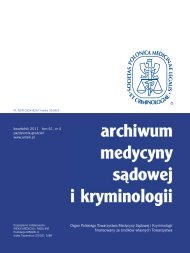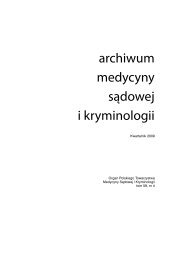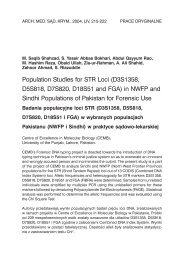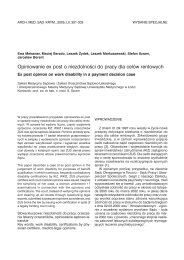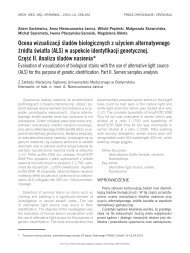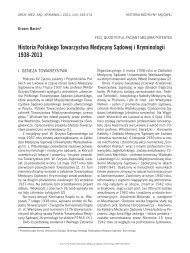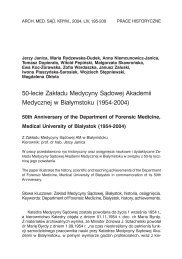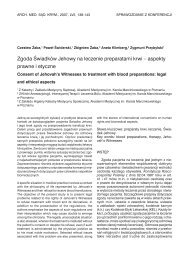PeÅny numer do pobrania (*.pdf) - Archiwum Medycyny SÄ dowej i ...
PeÅny numer do pobrania (*.pdf) - Archiwum Medycyny SÄ dowej i ...
PeÅny numer do pobrania (*.pdf) - Archiwum Medycyny SÄ dowej i ...
Create successful ePaper yourself
Turn your PDF publications into a flip-book with our unique Google optimized e-Paper software.
REGULAMIN OGŁASZANIA PRAC<br />
1. <strong>Archiwum</strong> <strong>Medycyny</strong> Są<strong>do</strong>wej i Kryminologii przyjmuje w języku polskim i angielskim:<br />
prace oryginalne, kazuistyczne, poglą<strong>do</strong>we oraz historyczne z medycyny<br />
są<strong>do</strong>wej, kryminalistyki i dziedzin pokrewnych, opracowania z zakresu etyki<br />
i deontologii lekarskiej, recenzje książek, sprawozdania z działalności PTMSiK,<br />
komunikaty Zarządu Głównego PTMSiK, sprawozdania ze zjazdów krajowych<br />
i zagranicznych, listy <strong>do</strong> Redakcji. Autor powinien podać, <strong>do</strong> jakiej kategorii zalicza<br />
tekst nadesłanej pracy.<br />
2. Prace przyjmuje Redakcja na adres mailowy w postaci pliku w formacie <strong>do</strong>wolnego,<br />
używanego powszechnie w Polsce procesora tekstu (typ pliku np. OpenDocument,<br />
Word lub sformatowany RTF), w stanie gotowym <strong>do</strong> składu, z zachowaniem<br />
obowiązujących zasad pisowni polskiej i polskiego mianownictwa.<br />
3. Praca powinna być napisana w formacie A4, z marginesami od góry, <strong>do</strong>łu, strony<br />
lewej i prawej po 2,5 cm, czcionką prostą wielkości 12 pkt. i z odstępami 1,5 wiersza<br />
(około 30 wierszy na stronie).<br />
4. Objętość całości (wraz z rycinami, tabelami, piśmiennictwem i streszczeniem) prac<br />
oryginalnych i poglą<strong>do</strong>wych nie powinna przekraczać 12 stron A4, kazuistycznych<br />
7 i innych 5. W uzasadnionych przypadkach Redakcja może przyjąć <strong>do</strong> druku<br />
pracę obszerniejszą.<br />
5. Na pierwszej stronie przed właściwym tekstem pracy należy umieścić imię i nazwisko<br />
autora (autorów), tytuł pracy w języku polskim i angielskim, nazwę instytucji,<br />
z której praca pochodzi oraz tytuł naukowy (skrót), pierwszą literę imienia i nazwisko<br />
kierownika akceptującego pracę. W kolejności należy przedstawić streszczenie<br />
w języku polskim, nie przekraczające 10 wierszy, zawierające cel i wyniki pracy bez<br />
informacji o metodyce. Poniżej należy zamieścić streszczenie w języku angielskim,<br />
zawierające cel i wyniki pracy oraz informacje o metodyce pracy. Następnie należy<br />
umieścić słowa kluczowe w języku polskim i angielskim.<br />
6. Właściwy tekst pracy rozpoczyna się od drugiej strony. Praca oryginalna powinna<br />
mieć typową strukturę (Wstęp. Materiał. Metoda. Wyniki. Dyskusja. Wnioski). Tytuły<br />
podrozdziałów powinny być umieszczone w oddzielnych wierszach. W tekście pracy<br />
należy zaznaczyć miejsca umieszczenia tabel i / lub rycin.<br />
7. Tabele i / lub ryciny należy zamieszczać w liczbie koniecznej <strong>do</strong> zrozumienia tekstu.<br />
Podpisy pod rycinami i ich oznaczenia oraz tytuły tabel wraz z objaśnieniami należy<br />
podawać w języku polskim i angielskim. Ryciny mają <strong>numer</strong>ację arabską, a tabele<br />
rzymską. Wielkość rycin powinna być taka, aby były one czytelne po zmniejszeniu<br />
ich podstawy <strong>do</strong> 120 mm. Tabele oraz ryciny (wykresy i fotografie) powinny być<br />
<strong>do</strong>łączone w postaci oddzielnych plików: pochodzących z powszechnie używanych<br />
programów biurowych i graficznych. Wskazane jest przygotowanie plików<br />
graficznych w formacie jpg.<br />
8. Tabele i ryciny drukowane są bez kolorów (w skali szarości). Jeśli autor życzy<br />
sobie wydrukowania elementów pracy w kolorze, powinien skontaktować się w tej<br />
sprawie z Redakcją. Wymagane jest pokrycie różnicy kosztów druku pomiędzy<br />
drukiem standar<strong>do</strong>wym a kolorowym (różne w zależności od zajęcia liczby arkuszy<br />
wydawniczych czy wkładki). W po<strong>do</strong>bny sposób możliwe jest <strong>do</strong>łączenie <strong>do</strong> <strong>Archiwum</strong><br />
płyty CD z plikami przydatnymi <strong>do</strong> ilustracji drukowanej pracy.<br />
9. Piśmiennictwo należy umieścić na oddzielnej stronie. W oryginalnej pracy nie<br />
powinno obejmować ono więcej niż 20 pozycji, w <strong>do</strong>niesieniu kazuistycznym 15,<br />
a w pracy poglą<strong>do</strong>wej 30. Wykaz piśmiennictwa należy ułożyć według kolejności<br />
cytowania w tekście, w osobnych liniach. Każda pozycja musi zawierać nazwisko<br />
i pierwszą literę imienia autora (autorów), tytuł pracy, tytuł czasopisma według<br />
skrótów używanych w lndex Medicus (w czasopismach pisanych cyrylicą przyjąć<br />
transkrypcję obowiązującą w Polsce) oraz kolejno rok, <strong>numer</strong> tomu, pierwszą<br />
i ostatnią stronę pracy (przykład: Autor A., Autor B.: Tytuł pracy. Arch. Med. Sąd.<br />
Kryminol. 2010, 60: 1-5). W przypadku pozycji książkowych należy ponadto<br />
podać pełny tytuł dzieła, wydawcę, miejsce i rok wydania.<br />
10. Na końcu pracy należy umieścić adres jednego z autorów (przede wszystkim<br />
e-mail), na który będzie kierowana wszelka korespondencja <strong>do</strong>tycząca pracy.<br />
11. Do pracy należy <strong>do</strong>łączyć pliki PDF zawierające podpisane:<br />
– zgodę Kierownika instytucji (Katedry, Zakładu) na opublikowanie pracy,<br />
– oświadczenie pierwszego autora, że praca nie została złożona równocześnie<br />
w innym czasopiśmie oraz że nie była w całości, jak i we fragmentach, wcześniej<br />
drukowana.<br />
12. W przypadku, gdy praca <strong>do</strong>świadczalna prowadzona była na osobach żyjących,<br />
na zwłokach lub na zwierzętach, należy <strong>do</strong>łączyć zgodę właściwej komisji uczelnianej<br />
na prowadzenie takich badań.<br />
13. Potwierdzenie otrzymania pracy <strong>do</strong> rozpatrzenia następuje drogą mailową na<br />
adres mailowy, z którego nadesłano pliki.<br />
14. Praca nie odpowiadająca Regulaminowi nie jest rozpatrywana pod względem<br />
merytorycznym. Wszystkie nadesłane prace zgodne z Regulaminem będą recenzowane.<br />
O nieprzyjęciu pracy <strong>do</strong> druku Redakcja informuje drogą elektroniczną<br />
(e-mail) wykazanego w pracy autora-korespondenta.<br />
15. Redakcja zastrzega sobie prawo <strong>do</strong>konywania niezbędnych poprawek, w tym<br />
stylistycznych i skrótów – bez porozumienia z Autorem.<br />
16. Honoraria autorskie za publikowane prace nie będą wypłacane. Autorzy nie<br />
otrzymują odbitek pracy: na stronie www.amsik.pl artykuł jest <strong>do</strong>stępny w pliku<br />
PDF w formie <strong>do</strong>kładnie takiej, jak został wydrukowany.<br />
17. Po akceptacji pracy <strong>do</strong> druku prawa autorskie zostają przekazane przez Autorów<br />
– Redakcji <strong>Archiwum</strong> <strong>Medycyny</strong> Są<strong>do</strong>wej i Kryminologii.<br />
GUIDE FOR AUTHORS<br />
1.The Archives of Forensic Medicine and Criminology is a peer-reviewed scientific<br />
journal published by the Polish Society of Forensic Medicine and Criminology<br />
(PTMSiK) for the publication in both the Polish and English languages of original<br />
articles, case reports, review articles, historical papers on forensic medicine, forensic<br />
science and related fields, medical ethics and deontology, activity reports and<br />
announcements of the PTMSiK, reports on national and international conferences,<br />
book reviews and letters to the Editor. The author should indicate which category<br />
refers to the text of the submitted work.<br />
2. The article should be submitted to the Editor by e-mail as a file in any format<br />
of commonly used word processing program (e.g. a file of the OpenDocument,<br />
Word or RTF type), with a proper application of grammar, spelling and terminology<br />
requirements.<br />
3. The paper should be submitted in A4 format with 2.5 cm margins at the top,<br />
bottom, left and right, font size 12 points and 1.5 line spacing (approximately<br />
30 lines per page).<br />
4. The volume of total original and review articles (including figures, tables, references<br />
and summary) should not exceed 12 A4 pages, for case reports – 7 pages, and for<br />
other papers – 5 pages. In justified cases, the editors may accept for publication<br />
a more extensive paper.<br />
5. On the first page, before the text itself, there should be indicated the name of the<br />
author (s), the title of the paper in both the Polish and English languages, the name<br />
of the institution from which the work originates, and the academic title (an acronym),<br />
the first letter of the first name and the full surname of the head of the institution,<br />
who approved the paper for submission. An abstract in Polish should not exceed<br />
10 lines, including the purpose and results of research, without information<br />
about the metho<strong>do</strong>logy. The abstract must be followed by an abstract in English,<br />
including the purpose and results of the research and information on the metho<strong>do</strong>logy<br />
of work. Then, the keywords in English and Polish should be placed.<br />
6. The proper text of the paper starts from the second page. Original paper should<br />
have a typical structure (Introduction. Material and Methods. Results. Discussion.<br />
Conclusions.). The titles of subsections should be placed in separate rows. The<br />
placement of tables and/or figures should be indicated in the text.<br />
7. The tables and/or figures must appear in the number which is necessary to<br />
understand the text. The legends to the illustrations and symbols employed, as<br />
well as the and titles of tables with explanations should be given in English and<br />
Polish. The figures are numbered using Arabic and the tables – Roman <strong>numer</strong>als.<br />
The size of the figures should be appropriate to be legible after reduction of the<br />
base to 120mm. The tables and figures (diagrams and photographs) should be<br />
attached as separate files formatted in commonly used office software and graphics.<br />
It is advisable to prepare the image files in the jpg format.<br />
8. The tables and figures are printed without color (the gray scale). The authors who<br />
wish to print elements of their paper in color should contact the Editor with respect<br />
to this issue: in such cases, the difference of costs between standard printing and color<br />
printing (depending on the area of printing sheet taken up by color parts of the<br />
publications/inserts) should be fully covered by the authors. In a similar manner, it is<br />
possible to attach to the journal a CD with files useful to illustrate the publication.<br />
9. References should be placed on a separate page. In original papers, the section<br />
„References“ should not include more than 20 items, in case reports – 15, and in<br />
review papers – 30. The list of references should be arranged in order of citation<br />
in the text in separate lines. Each entry must contain the surname and the first letter<br />
of the author’s (autohors’) name, title, journal title according to the abbreviations<br />
used in the Index Medicus (in journals written in Cyrillic – a Latin transcription)<br />
and subsequently the year, volume number, first and last pages of the paper, as<br />
per the following example: Author A, Author B: The_title_of the paper, Arch Med<br />
Sa<strong>do</strong>wej Kryminol. 2010, 60 (1): 1-5. In the case of handbooks, the full title,<br />
the publisher, place and year of publication should be also specified.<br />
10. At the end of the paper, the address of one corresponding author (especially<br />
the e-mail address) should be specified.<br />
11. The files containing the paper for publication should have PDF files attaches,<br />
the files containing:<br />
– the consent of the Head of the institution (Chair, Department) for publication<br />
of the paper,<br />
– the statement of the first author that the manuscript has not been submitted<br />
simultaneously to another journal and that it was not, in its entirety or fragments,<br />
printed in another journal.<br />
12. If the experimental study was conducted in living people, cadavers or animals,<br />
the approval of an appropriate university commission for carrying our such research<br />
should be included.<br />
13. The confirmation of receipt of the paper for evaluation will be sent to the e-mail<br />
address from which the files were submitted.<br />
14. Papers not adhering to the above specified the Regulations shall not be evaluated.<br />
The articles prepared works in accordance with the Regulations will be reviewed.<br />
The Editors will dispatch notification about the refusal to accept the paper for<br />
publication via e-mail to the address of the corresponding author.<br />
15. The Editors reserve the right to make necessary corrections, including stylistic<br />
revisions and shortening the text, without consulting the author.<br />
16. No royalties shall be paid for the published works. The authors <strong>do</strong> not receive<br />
printouts of the published papers: the articles are available as PDF files exactly<br />
as printed on the website www.amsik.pl.<br />
17. The copyrights to papers accepted for publication will be transferred by the<br />
authors to the Editors of the Archives of Forensic Medicine and Criminology.<br />
Copyright © by Polskie Towarzystwo <strong>Medycyny</strong> Są<strong>do</strong>wej i Kryminologii, Kraków 2012<br />
Projekt znaku graficznego PTMSiK na okładce – Wiktor Ostrzołek<br />
Wydawca: Polskie Towarzystwo <strong>Medycyny</strong> Są<strong>do</strong>wej i Kryminologii<br />
Realizacja wydawnicza i druk:<br />
Agencja Reklamowa „Po Godzinach“, ul. Podedworze 10/54, 30-686 Kraków<br />
tel. +48 12 623 77 74, +48 609 633 948, e-mail: biuro@pogodzinach.com.pl, www.pogodzinach.com.pl



